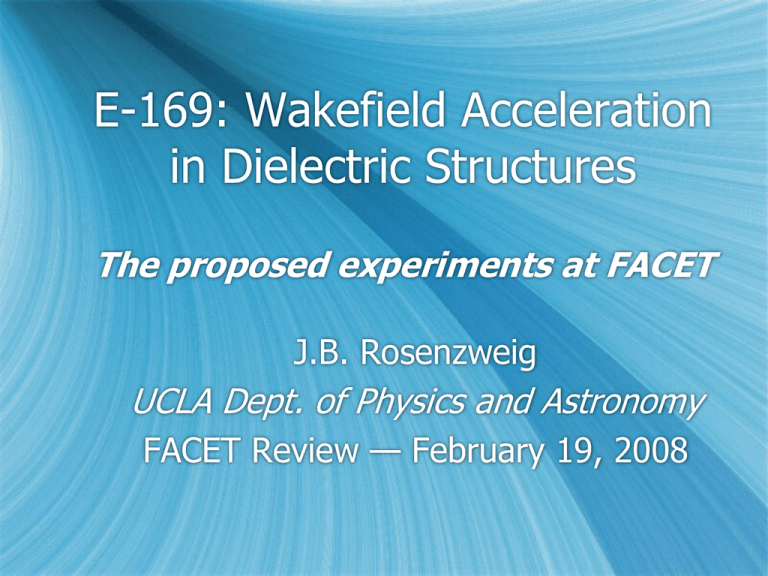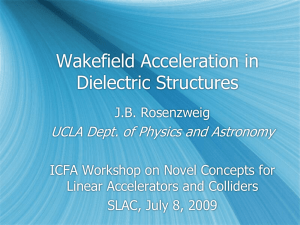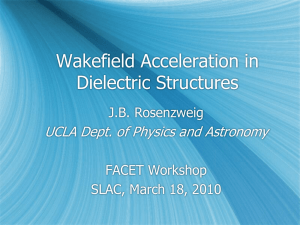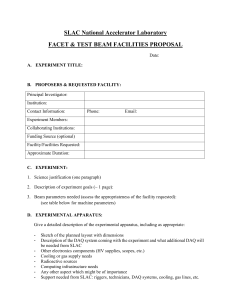E-169: Wakefield Acceleration in Dielectric Structures The proposed experiments at FACET
advertisement

E-169: Wakefield Acceleration in Dielectric Structures The proposed experiments at FACET J.B. Rosenzweig UCLA Dept. of Physics and Astronomy FACET Review — February 19, 2008 E169 Collaboration QuickTime™ and a TIFF (U ncompressed) decompressor are needed to see this picture. QuickTime™ and a decompressor are needed to see this picture. UCLA H. Badakov, M. Berry, I. Blumenfeld, A. Cook, F.-J. Decker, M. Hogan, R. Ischebeck, R. Iverson, A. Kanareykin, N. Kirby, P. Muggli, J.B. Rosenzweig, R. Siemann, M.C. Thompson, R. Tikhoplav, G. Travish, D. Walz Department of Physics and Astronomy, University of California, Los Angeles Stanford Linear Accelerator Center University of Southern California Lawrence Livermore National Laboratory Euclid TechLabs, LLC Collaboration spokespersons E-169 Motivation Take advantage of unique experimental opportunity at SLAC FACET: ultra-short intense beams Advanced accelerators for high energy frontier Very promising path: dielectric wakefields Extend successful T-481 investigations Dielectric wakes >10 GV/m Complete studies of transformational technique Colliders and the energy frontier Colliders uniquely explore energy frontier Exp’l growth in equivalent beam energy w/time Livingston plot: “Moore’s Law” for accelerators We are now falling off plot! Challenge in energy, but not only…luminosity as well How to proceed to linear colliders? Mature present techniques Discover new approaches Meeting the energy challenge Avoid gigantism Cost above all Higher fields implied Higher fields give physics challenges Linacs: accelerating fields Enter world of high energy density (HED) physics Impacts luminosity challenge… HED in future colliders: ultra-high fields in accelerator High fields in violent accelerating systems eE z /mcw ~ 1 High field implies high w Relativistic oscillations… Limit peak power, stored energy Challenges Breakdown, dark current Pulsed heating Where is source < 1 cm? Approaches Superconducting High frequency, normal conducting Lasers and/or plasma waves, or… QuickTime™ and a Photo - JPE G decompressor are needed to see this picture. Scaling the accelerator in size Lasers produce copious power (~J, >TW) Scale in size by 4 orders of magnitude < 1 m gives challenges in beam dynamics, loading Reinvent the structure using dielectric (E163, Neptune) Resonant dielectric structure schematic To jump to GV/m, only need mm-THz Must have new source… Possible new paradigm for high field accelerators: wakefields Coherent radiation from bunched, v~c e- beam Any impedance environment Powers next generation or exotic schemes Plasma, dielectrics… Non-resonant, short pulse operation possible High fields without breakdown? Intense beams needed by other fields X-ray FEL, X-rays from Compton scattering THz sources for imaging with chemical signature CLIC V.O.: High gradients, high frequency, EM power from wakefields CLIC drive beam extraction structure Power CLIC 30 GHz, 150 MV/m structures CLIC wakefield-powered resonant scheme Simpler approach: Collinear dielectric wakefield accelerator Higher accelerating gradients: GV/m level Dielectric based, low loss, short pulse Higher gradient than optical? Different breakdown mechanism No charged particles in beam path… field configuration simpler Wakefield collider schemes Modular system Afterburner possibility Spin-offs THz radiation source Imaging, acceleration… "Towards a Plasma Wake-field Acceleration-based Linear Collider", J.B. Rosenzweig, et al., Nucl. Instrum. Methods A 410 532 (1998) Dielectric Wakefield Accelerator Electromagnetic characteristics Electron bunch drives Cerenkov wake * in cylindrical dielectric structure Variations on structure features Multimode excitation Wakefields accelerate trailing bunch Mode wavelengths Design Parameters a,b z n 4 b a 1 n Peak decelerating field Transformer ratio Ez on-axis, OOPIC eE z,dec 4N b re mec 2 8 a z a 1 R E z,acc 2 E z,dec Extremely good beam needed OOPIC Simulation Studies Parametric scans Heuristic model benchmarking Analyze experiments: Field values Beam dynamics Radiation production 1.5 10 Multi-mode excitation (short bunch) 10 E_dec,max (OOPIC) E_acc max (OOPIC) E_dec,theory 10 Single mode excitation (longer bunch) z E (V/m) 1 10 5 10 9 0 40 60 80 100 120 140 160 a (m) Example scan, comparison to heuristic model Fundamental Experimental Background Argonne / BNL experiments E vs. witness delay Proof-of-principle experiments (W. Gai, et al.) ANL AATF Mode superposition (J. Power, et al. and S. Shchelkunov, et al.) ANL AWA, BNL Transformer ratio improvement (J. Power, et al.) Beam shaping Tunable permittivity structures For external feeding (A. Kanareykin, et al.) Tunable permittivity Gradients limited to <50 MV/m by available beam T-481: Test-beam exploration of breakdown threshold Leverage off E167 Existing optics, diagnostics, protocols Goal: breakdown studies Al-clad fused silica fibers ID 100/200 m, OD 325 m, L=1 cm Multi-photon v. tunneling ionization Beam parameters predict ≤12 GV/m longitudinal wakes 30 GeV, 3 nC, z ≥ 20 m 48 hr FFTB run, Aug. 2005 Follow-on planned, no FFTB time PRL on breakdown threshold produced T-481 “octopus” chamber T481: Beam Observations Multiple tube assemblies Alignment to beam path Scanning of bunch lengths for wake amplitude variation Excellent flexibility: 0.5-12 GV/m Vaporization of Al cladding… use dielectric, more robust Breakdown monitored by light emission Correlations to post-mortem inspection View end of dielectric tube; frames sorted by increasing peak current Breakdown Threshold Observation Breakdown Camera Pixel Sum 2.40 107 08170cs 2.20 107 2.00 107 1.80 107 1.60 107 1.40 107 1.20 107 1.00 107 0 50 100 150 Bunch Length Variable [rms XRAY] X-ray data yields bunch length, current 200 T-481: Inspection of Structure Damage Damage consistent with beam-induced discharge ultrashort bunch Bisected fiber longer bunch Aluminum vaporized from pulsed heating! Laser transmission test Striking conclusions Observed breakdown threshold (field from simulations) Esurf >13 GV Eacc>5 GV/m! Much higher than laser data (1.1 GV/m for 100 psec) Tunneling ionization dominant Multi-mode excitation gives effective shorter pulses? E169 at FACET Approved by SLAC EPAC 12/06 Research >GV/m acceleration scheme in DWA Push technique for next generation accelerators Goals: Explore breakdown issues in detail Varying tube dimensions Change impedance, mode content Breakdown dependence on wake pulse length Determine usable field envelope Coherent Cerenkov radiation measurements: Explore alternate materials (diamond, etc) Observe acceleration Explore alternate structure designs Examine deflecting modes, transverse BBU Push to modular DWA demonstration (1 m section) E-169 at FACET High-gradient acceleration research Goals in 3 Phases Phase 1: Complete breakdown study explore (a, b, z) parameter space Alternate cladding Alternate materials (e.g. diamond) Explore group velocity effect T Ld /c vg Ld / c 1 Coherent Cerenkov (CCR) measurement Total energy gives field measure UC eN b E z,dec Ld 2 Harmonics are sensitive z diagnostic 2 nN b re mec z L n z d Un exp 2 2b a 1 2ab a 8 1 z 1a 2 2 2 2 z ≥ 20 m r < 10 m U 25 GeV Q 3 - 5 nC E-169 at FACET: Phase 2 & 3 Phase 2: Observe acceleration, explore new designs 10 cm tube length longer bunch, z ~ 150 m z 150 m moderate gradient, 1 GV/m r < 10 m U 25 GeV Q 3 - 5 nC single mode operation Phase 3: Scale to 1 m fibers Alignment QuickTime™ and a TIFF (LZW) decompressor are needed to see this picture. Group velocity & EM exposure Transverse BBU Before & after momentum distributions (OOPIC) Ez on-axis Experimental Issues: THz Detection Conical launching horns Impedance matching to free space Direct radiation forward Fabrication, test at UCLA Neptune Signal-to-noise ratio Background of CTR from tube end SNR ~ 3 - 5 for 1 cm tube Detectors Pyroelectric Golay cell Helium-cooled bolometer Michelson interferometer for autocorrelation QuickTime™ and a TIFF (LZW) decompressor are needed to see this picture. Autocorreation of coherent edge radiation at BNL ATF, 120 fsec beam Experimental Issues: Alternate DWA design, cladding, materials A. Kanareykin Aluminum cladding used in T-481 Vaporized at even moderate wake amplitudes Low threshold from low pressure, thermal environment Dielectric cladding Lower refractive index provides internal reflection Low power loss, damage resistant Alternate dielectric: CVD diamond CVD deposited diamond High breakdown threshold Doping gives low SEC Available for Phase I (Euclid) Phase 2 Bragg fibers 2D photonic band gap structures? Bragg fiber Alternate design: Slab structure Slab structure familiar from resonant laser idea Suppresses BBU! Ultra-short bunch means ~GV/m fields still obtainable Example: Ez~ 700 MV/m E-169 at FACET: Implementation/Diagnostics New precision alignment vessel Upstream/downstream OTR screens for alignment X-ray stripe CTR/CCR for bunch length Imaging magnetic spectrometer Beam position monitors and beam current monitors Controls… Heavy SLAC involvement Much shared with E168 E169 Game Plan and Timeline Design, initial construction Go Cerenkov production FACET beam commissionin g UCLA Neptune experiments 2008 Slab structures Breakdown studies 2009 Alternate materials 10 cm module acceleration Novel cylindrical structures 2010 1 m multi-GeV design study 1 m multi-GeV acceleration experiments (witness beam) 10 cm module BBU studies 2011 Path to staging 2012 Conclusions/directions Extremely promising initial run Collaboration/approach validated Physics tantalizing; new regime for dielectric acceleration must be explored Unique opportunity to explore GV/m dielectric wakes at FACET Flexible, ultra-intense beams Only possible at SLAC FACET Complementary low gradient experiments at Neptune Conceptual, experimental, and personnel synergies with E168…



